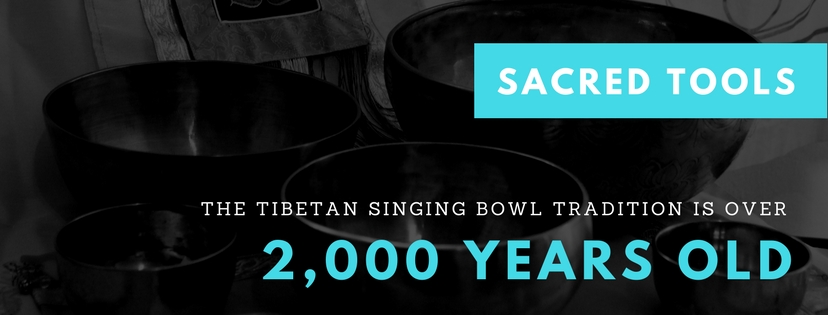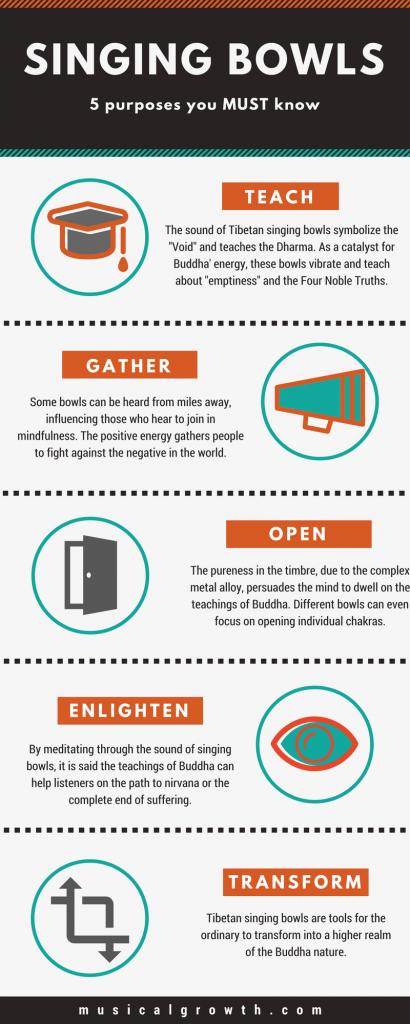*Originally published on Feb. 20, 2018. Last updated on April 12, 2018.*
Unfortunately, the history of Tibetan singing bowls has been lost due to the near complete destruction of Tibet’s monasteries in the 1950’s due to the communist Chinese military occupation.

Luckily, I’ve found a few trustworthy sources for some interesting information most people don’t know about. These sacred tools need to be respected and cared for properly – without an accurate knowledge of Tibetan singing bowls history, the user may not understand the context.
As a quick example, Americans are taught not to drop the national flag on the ground out of respect for the colors. Singing bowls are sacred and should also be cared for properly – at least if you respect the culture.
This article’s organization:
- Introduction to the Material
- History of Tibetan Singing Bowls
- Their True Purpose
- My Recommendations
Introduction to the Material
According to Rain Gray from Bodhisattva.com, many monks and people of the Himalayas know very little of Tibetan singing bowls – he had actually travelled and researched the history of singing bowls for over 8 years. At the time of publication, these bowls were fairly new to the Western world and information about their background was in demand.
Thanks to Rain Gray’s determination, he was able to interview two Tibetan-born, Buddhist monks on October 7, 1986, about the historical use of singing bowls. I would just like to say thank you to Rain Gray, Lama Lobsang and Lama Lobsang Molam for sharing their research with the world through their article.
The article itself is only a transcript of this interview and because of their broken English, difficult concepts were hard to understand – so in the spirit of spreading the Dharma (teachings of Buddha), I hope I’ve covered and re-explained things from Mr. Gray’s article and other sources in a friendlier format (though I do invite you to read Gray’s original article as well).
History of Tibetan Singing Bowls
The music of Tibetan monasteries are quite varied, not just in different pitched singing bowls, but in the variance of instruments. Miles away, a temple gong can be heard calling upon the surrounding inhabitants to stay mindful. The “purr of a well-blown conch,” reed-blown clarinets, drums, cymbals, and large two-manned trumpets (up to 18 feet long!) are also common practice. All music and sounds produced by Buddhist monasteries followed the principle of “interdependence, interrelationship, and interaction functions” (according to the journal article, Asian Music).
Buddhist singing bowls have been linked to the very first teachings of Buddha as a means of teaching (among other things such as healing). The first metal bowls were estimated to have been made of pure copper over 5,000 years ago., but Tibetan bowls were estimated to have been made over 2,000 years ago – but as I had said at the beginning, the communist Chinese regime burnt precious Tibetan monasteries that practically erased most of the written record of singing bowls.

Today, we must rely on the traditions and knowledge passed down from generation to generation and luckily, the mysticism of the Tibetan culture hasn’t changed. Dwelling at the highest point of the world with the surrounding Kunlun and Himalaya Mountains, Tibet sources mighty rivers that flow down to India and China. According to an article in the Social Science journal, the first time a European (Friar Odoric) visited Tibet, a written account of the experience in 1330 C.E. read:
“Those who are born here (Tibet) have very long lives… [and possess] clear understandings and good memories… they deserve honour above all other men.”
Fortunately, in 1986, Rain Gray from Santa Monica, CA was determined to find some answers about singing bowls after a long 8 years of personal research with little reward. Gray finally sat down with two Tibetan Buddhist monks to ask questions and hear the valuable teachings of singing bowls that have been handed down through speech and tradition.
Originally there were three singing bowls (relics as they say) that were kept safe behind the Drepung, Narthang, and Sakya Monasteries in Tibet. Unfortunately, Lama Lobsang Molam inferred that there only one left at the Drepung Monastery.
These precious relics are said to have been originally used by the historical Buddha (Shakyamuni) as a teaching tool who taught through language and energy. Singing bowls being the tool for his energy. The original relics were special in that legend states: those with negative karma produce lesser quality tones from these original singing bowls, whereas those with positive karma produce pure tones.
Singing bowls are notoriously complicated in their metal alloys that are said to contain 5, 7, or 9 different metals, one of these metals being the rare meteorite iron. Tibet has a special, “extra pure” type of meteorite iron thought to be the reason why Tibetan singing bowls have especially pure sounds and resonant abilities.

Their True Purpose
Although the history of singing bowls are a little convoluted, the traditional use has been passed down through the generations. According to the interview conducted by Rain Gray, the purpose of Tibetan singing bowls are a bit different from the Western world tends to believe.
The purpose of singing bowls:
- Teach
- Symbolized the “Void” and teaches the Dharma
- The vibrations teach about “emptiness” and keeps listeners away from Narak (“hell realm or lower realm”)
- Is a gateway for Buddha’s energy to pass through by vibrations and teach about the Four Noble Truths
- With the teachings from singing bowls, the listener may be equipped to join Shambhala (a mythical kingdom ruled by the “future Buddha”)
- Gather
- Those in the area will be influenced to join in mindfulness
- The positive energy will gather people to fight against those who try to destroy or conquer the world
- Even “hungry ghosts” can hear the sound thousands of miles away (according to Lama Lobsang Molam)
- Transform
- Singing bowls are tools for the ordinary to transform into a higher realm of the Buddha nature
Listeners of singing bowls are to dwell on the Dharma or the teachings of the Shakyamuni Buddha (or Siddhartha, the historical Buddha), which most importantly can be tied to the Four Noble Truths:
- (1)The Truth of Suffering
- All existence is suffering
- (2) The Truth of Cause
- Suffering is caused by ignorance and can in-turn cause craving and illusion
- (3) The Truth of Extinction
- There is an end of suffering: nirvana or enlightenment which is the state of no suffering
- (4) The Truth of the Path
- Nirvana is attained through practicing the Eightfold Noble Path
So for the layman: Tibetan singing bowls help in attaining peace of mind. The vibrations of a singing bowl produce a sound of the “Void” and are derived from the Buddha’s energy transmitted through its resonance. Listening, in turn, helps us along the path to enlightenment and the end of suffering.
Of course, after reading the fourth Noble Truth, the next question is inevitable: “what is the Eightfold Path?”
The Eightfold Noble Path (simply put):
- Samma ditthi – Right understanding
- Samma sankappa – Right thought
- Samma vaca – Right speech
- Samma kammanta – Right action
- Samma ajiva – Right livelihood
- Samma vayama – Right effort
- Samma sati – Right mindfulness
- Samma samadhi – Right concentration
If you’re interested in these ideologies, I would highly recommend conducting your own research and contacting your local Buddhist sanctuary. I am not advocating or pushing any religion, but want to provide basic information to anyone who is interested.
Spirituality is for everyone and the teaching of Buddha can be used as a guideline no matter if you are Buddhist or not. Religions across the world tend to have similar characteristics of behavior that generally relate to “do no harm” and the golden rule: “treat others as you would like to be treated.”
Keep an open mind. Review and research these teachings as they may add valuable insight into a more simplistic life. But as I always say, take everything with a grain of salt.
My Recommendations
Because true singing bowls are from a long tradition of caring production, you have to be aware of a few key characteristics when searching for your own singing bowls. The “self-help” industry tends to mass produce popular items without caring as much about authenticity or perhaps even quality.
There are a few amazing brands that are less than $100! So if you’re looking for a newly made singing bowl that I’d recommend, definitely read this article: Singing Bowls Sale – Under $100!
I’m still reviewing antique singing bowls at the moment, but I would highly recommend checking out iSingingBowls.com – that’s where most of the bowls I trust come from.
Musicologist, Rain Gray, goes to the Himalayan mountains to choose from 50,000 singing bowls and after testing each of them in person, he only takes 1 out of every 200. He’s very picky! So you know each bowl iSingingBowls.com has for sale is of the greatest quality.
Conclusion
Tibetan singing bowls are sacred tools and we who are fortunate enough to own these bowls must respect their purpose and ancient tradition by caring for them properly.
The next coming Buddha is known as “Maitreya,” which can be translated as “harmonic resonance.” Sound can invite energy into the soul and speak to one’s heart on a very different level than language can (I have always thought words can be distracting – I would much rather sing or play my emotions versus explaining them).
Much like Himalayan pink salt lamps, yoga, or meditation, singing bowls have been a recent trend for good reason. But I doubt many people know of the true nature and purpose behind these mythical tools.
I would invite you to share this information with anyone you know so we can help preserve the proper long-standing tradition of Tibetan singing bowls. Without an accurate understanding of their context, one may never respect and care for their own singing bowl properly.
My handmade Tibetan singing bowl has always been a cherished possession of mine, but after researching and finding out the tradition of these bowls, I’ve come to really respect the craftsmanship and amazing sound it produces.
You’d probably be interested in this article!
What are your thoughts after reading this article? Has it changed your perspective toward Tibetan singing bowls? I would love to hear from you!
Thanks for reading!
Chase
Feb. 2018

Sources
BestSingingBowls.com – https://bestsingingbowls.com/history-singing-bowls/
Gray, Rain. Bodhisattva.com. Site: https://www.bodhisattva.com/singing_bowl_history.htm
Jennings, Walter. “Tibetan Civilization.” Social Science, vol. 2, no. 3 (1927): 243-289.
Lhalungpa, Lobsang. “Tibetan Music: Secular and Sacred.” Asian Music vol. 1, no. 2 (1969): 2-10.
Tricycle – https://tricycle.org/magazine/noble-eightfold-path/
Wikipedia – https://en.wikipedia.org/wiki/Shambhala#In_the_Buddhist_Kalachakra_teachings




5 Comments
Joann · February 26, 2018 at 5:22 am
This was a very interesting and enlightening read! It’s such a shame that those Tibetan monasteries were burnt down, all that history gone. Luckily some things were preserved and the knowledge was passed down. I’ve always been fascinated with Buddhism and meditation, but never really thought about singing bowls. I’ve listened to meditation music with resonating singing bowls and do find it very good for meditation.
I might consider investing in one myself! They are very beautiful. Thanks for sharing!
Chase Chandler · February 26, 2018 at 8:45 am
I’m glad you found the article interesting! Traditions have definitely been passed down, but translating it to English is difficult. It took me a few hours to understand two monks from this interview’s transcript I found (mentioned in the article). But I do hope I presented the info in a friendly way! Appreciate the feedback and stay tuned for my recommendations for singing bowls – I’m still reviewing!
Rita and Phil Crosbie · January 17, 2021 at 8:51 am
Hi Chase, thank you for sharing. We are currently doing research for our re-vamped site and we are always hungry for more information on sound and its healing qualities.
The monks words were fascinating – we have been full time ‘sound healers’ for over 10 years and many of our clients – and us too – have experienced that ‘void’ of which they speak when using bowls and particularly gongs with their deep and powerful harmonic overtones.
All of their words that you report simply ring true (pun intended)! Thank you for this informative article and if we may, we would like to reference it at some time in the future.
How would you like us to do that if you agree?
With thanks,
Phil Crosbie Soundbeings.com
Chase Chandler · February 13, 2021 at 9:49 pm
This is wonderful feedback! Thank you so much for sharing your experience and understanding. I’m so glad everything “rung true” as you say! You are of course welcome to refer to this article’s information – if you do, just let me know in advance by contacting me directly! Thank you – so glad you liked this article!
Sergio Martone · August 8, 2021 at 5:41 am
I have recently become interested in Singing Bowls.
I have purchased three at the moment. I know very little about how to care for them.
Whether it is ‘disrespectful’ to polish them or give them a good cleaning with washing up liquid.
I haven’t done that, by the way!
Comments are closed.